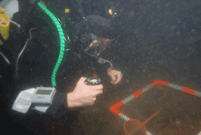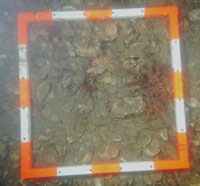Monitoring
Monitoring

The Modiolus Restoration Research Group has devised a sampling strategy to monitor the temporal trends of associated M. modiolus fauna over a three-year period. This will help determine whether the general condition of the M. modiolus beds in Strangford Lough is improving or deteriorating over time. The aims of the monitoring programme are to determine variation in:
1) faunal assemblages of pristine/good and compromised M. modiolus beds in the north and south basins of Strangford Lough;
2) the densities of adult M. modiolus in pristine/good and compromised sites in the north and south basins of Strangford Lough.
3) recruitment of M. modiolus in pristine/good and compromised sites in the north and south basins of Strangford Lough.

Randomly positioned quadrat over a horse mussel bed in Strangford Lough (Photo: MRRG)
Monitoring methods involve analysis of the temporal reef structure using a randomly stratified quadrat design and a broader scale monitoring effort using 100 m transects. During the quadrat and transect surveys photographic stills of the epifauna and mega-infauna (among other relevant data such as dead and living mussel density, reef structure classification and visible impacts) are collected and analysed in the Marine Station laboratory. The MRRG researchers are experienced marine taxonomists involved in the National Marine Biological Analytical Quality Control Scheme and they regularly participate in Video and Stills AQC ring tests under the NMBAQC. This ensures quality control and data assurance.


